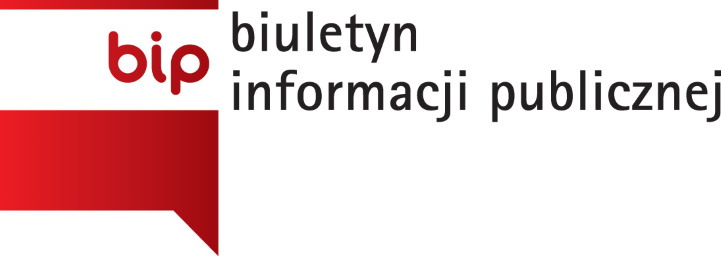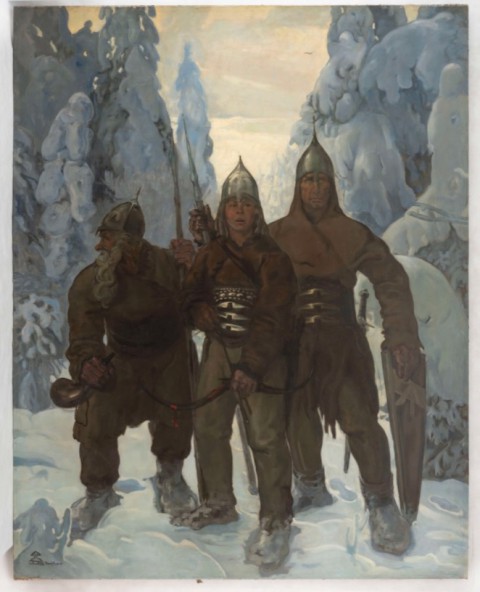“Piastuny” by Tadeusz Pruszkowski from the collection of the National Museum in Lublin
Three warriors march through the thicket of tall trees covered with a thick layer of snow. Dark brown silhouettes stand out strongly from the white of the snow curtain and the frosty sky glittering above them. Silver helmets and buckles of ornate belts glisten in the twilight. They tread carefully. The bearded old man wielding the hunting horn, looks carefully from side to side and listens. Next to it is a tall companion with a sword at his side, a spear in one hand, and a shield in the other hand. The youngest warrior, still a boy, goes ahead, holding a bow ready to shoot in front of him. This is how we can describe the "plot" of Tadeusz Pruszkowski's painting Piastuny from 1917, monumental in its composition and expression. The content and meaning of the scene depicted are puzzling. Who are its title characters? ‘Piastuny’ (guardians) were formerly defined as high court officials entrusted with the upbringing of royal or princely sons. The two older men shown in the picture are such guardians and teachers of the boy. They are making him accustomed to the dangers of hunting.
From a Slavic warrior to a legionary soldier
The work has several complementary meanings, which should be associated with the uprising, when the fate of Poland was at stake and regaining sovereignty was becoming increasingly probable. The mood was reflected in the art of that time. Tadeusz Pruszkowski, a young painter and a legionnaire who returned from the front, painted several works related in terms of content and form. In 1916, he presented The Legend of Sleeping Knights, followed by Piastuny the year after. Their subjects were motifs and figures from the early history of Poland, intertwined with legendary tales about the beginning of the nation and its founders. The warriors-guardians are a symbolic personification of Slavic ancestors – the Piasts. The highlighted details of the outfit, i.e. elaborate belts, bring to mind highlander costumes. This in turn alludes to the then popular legend of the royal army sleeping near the Giewont, perfectly reflecting the mood of national expectations and aspirations.
Pruszkowski – a lover of art and life
Pruszkowski's two early canvases (from which only Piastuny has survived to this day) are an exception to his oeuvre. He painted mostly portraits, sometimes landscapes and still lifes. The painter drew inspiration from the art of the Renaissance and Baroque masters, distancing himself from avant-garde concepts. The author of the works, enchanting with their freedom, luminous colour and expression, is remembered equally as an animator and a colourful figure of the interwar cultural life. Pruszkowski was a cheerful, big-hearted and generous man with vivid imagination, constantly curious about the world. He was not only a painter, but also a teacher, traveller, rally driver, pilot, violin virtuoso, and even a film director. In 1926, together with his students, he made a film with the surreal title: The Happy Hangman, or California in Poland. He dealt with art matters as a decision-maker at the Institute of Art Propaganda. He was an initiator of various artistic projects: competitions, exhibitions, government orders; and a founder of many artistic groups, publisher and critic. It should be remembered that in the 1920s Pruszkowski artistically revived and made famous the town of Kazimierz Dolny, located near Lublin. He lived there in a fancy villa with a round tower and ran a paint shop, which was the cradle of the Brotherhood of St. Luke. Every year he organized painting workshops in the town. Among his many activities, the work of a teacher was the most important, which is indirectly reflected in Piastuny. His inborn predispositions and kindness combined with the commitment to create a Polish painting school resulted in training a large group of students. Those of them who escaped death during World War II went down in the history of Polish art. The master was not allowed to enjoy their achievements as he was shot by German soldiers in 1942.
Bożena Kasperowicz
The project “www.muzeach” is co-financed from European Funds and from the funds of the Ministry of Culture and National of the Republic of Poland. The project is implemented under the Operational Programme Digital Poland for the years 2014-2020, Priority Axis 2 “E-government and open government,” Action 2.3 “Digital availability and usefulness of public sector information,” Sub-action 2.3.2 “Digital availability of culture resources.”

suggested

Henryk Lubomirski as Cupid in the collection of the Castle Museum in Łańcut
Henryk Lubomirski was born in 1777 in Rivne in Volhynia. He was the son of Józef, the castellan of Kiev, …

Project “www.muzeach” from the point of view of art restorers at the National Museum in Lublin
The creation of a common website sharing digital resources of the five museums participating in the “www.muzeach” project was a …

About the project “www.muzeach”
About the project www.muzeachThe project „www.muzeach” aims to provide public access to digital resources in one place. “We share knowledge …















